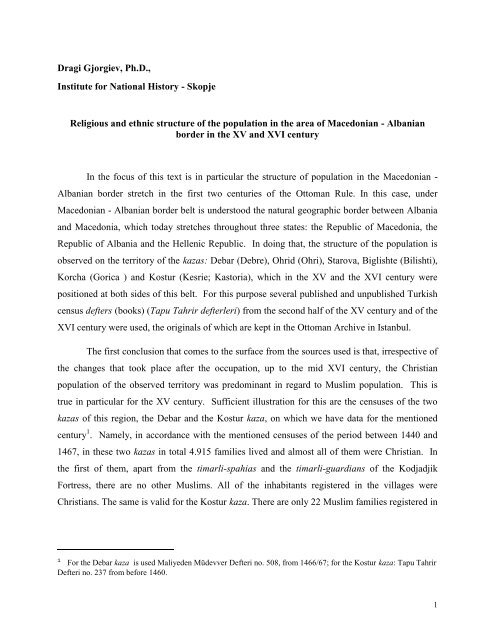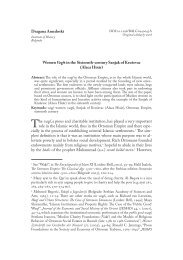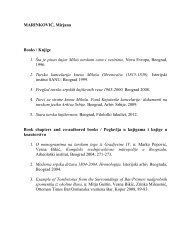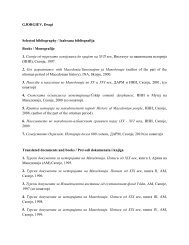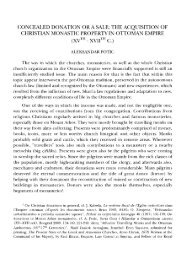Dragi Gjorgiev, Ph.D., Institute for National History - Skopje ...
Dragi Gjorgiev, Ph.D., Institute for National History - Skopje ...
Dragi Gjorgiev, Ph.D., Institute for National History - Skopje ...
You also want an ePaper? Increase the reach of your titles
YUMPU automatically turns print PDFs into web optimized ePapers that Google loves.
<strong>Dragi</strong> <strong>Gjorgiev</strong>, <strong>Ph</strong>.D.,<br />
<strong>Institute</strong> <strong>for</strong> <strong>National</strong> <strong>History</strong> - <strong>Skopje</strong><br />
Religious and ethnic structure of the population in the area of Macedonian - Albanian<br />
border in the XV and XVI century<br />
In the focus of this text is in particular the structure of population in the Macedonian -<br />
Albanian border stretch in the first two centuries of the Ottoman Rule. In this case, under<br />
Macedonian - Albanian border belt is understood the natural geographic border between Albania<br />
and Macedonia, which today stretches throughout three states: the Republic of Macedonia, the<br />
Republic of Albania and the Hellenic Republic. In doing that, the structure of the population is<br />
observed on the territory of the kazas: Debar (Debre), Ohrid (Ohri), Starova, Biglishte (Bilishti),<br />
Korcha (Gorica ) and Kostur (Kesrie; Kastoria), which in the XV and the XVI century were<br />
positioned at both sides of this belt. For this purpose several published and unpublished Turkish<br />
census defters (books) (Tapu Tahrir defterleri) from the second half of the XV century and of the<br />
XVI century were used, the originals of which are kept in the Ottoman Archive in Istanbul.<br />
The first conclusion that comes to the surface from the sources used is that, irrespective of<br />
the changes that took place after the occupation, up to the mid XVI century, the Christian<br />
population of the observed territory was predominant in regard to Muslim population. This is<br />
true in particular <strong>for</strong> the XV century. Sufficient illustration <strong>for</strong> this are the censuses of the two<br />
kazas of this region, the Debar and the Kostur kaza, on which we have data <strong>for</strong> the mentioned<br />
century 1 . Namely, in accordance with the mentioned censuses of the period between 1440 and<br />
1467, in these two kazas in total 4.915 families lived and almost all of them were Christian. In<br />
the first of them, apart from the timarli-spahias and the timarli-guardians of the Kodjadjik<br />
Fortress, there are no other Muslims. All of the inhabitants registered in the villages were<br />
Christians. The same is valid <strong>for</strong> the Kostur kaza. There are only 22 Muslim families registered in<br />
1<br />
For the Debar kaza is used Maliyeden Müdevver Defteri no. 508, from 1466/67; <strong>for</strong> the Kostur kaza: Tapu Tahrir<br />
Defteri no. 237 from be<strong>for</strong>e 1460.<br />
1
this kaza, and all of them as inhabitants of the town of Kostur. 2 In the villages of this kaza, apart<br />
from the owners of timars, i.e. the feudal lords, there is no register of a single Muslim.<br />
For the other kazas in this border region there are no data <strong>for</strong> the XV century. However,<br />
judging by the number of Muslims in them in the beginning of the XVI century, it is certain that<br />
their religious structure in the second half of the XV century was identical with the two<br />
previously mentioned kazas, i.e. that they were inhabited exclusively with Christian population.<br />
Certain increase in the Muslim population was noticed in the period between 1520-1540.<br />
According to the used defters from that period, 3 Muslims were registered in all observed kazas.<br />
In the Debar kaza, in which in 1466/7, apart from the feudal lords, there were no other Muslims,<br />
now we have 103 Muslim families registered, and in the Kostur kaza the number of Muslim<br />
families raises from 22 to 150. In the other kazas the number of Muslim families looks like this:<br />
Ohrid - 102 families; Starova - 8 families; Korcha - 236 families; and Biglishta - 130 families.<br />
Otherwise, in this time period the total number of inhabitants in the Macedonian - Albanian<br />
border belt was 36.847 families. Of them, 36.118 were Christian, and 729 Muslim, or expressed<br />
in percentages 98% were Christians and only 2% were Muslims. Having in view these numbers,<br />
it is obvious that the population in the Albanian-Macedonian stretch up to the middle of XVI<br />
century remained homogeneous and had almost entirely belonged to the Christian community. It<br />
is important to emphasize that the Muslims in their greater part were concentrated in the towns.<br />
Only in Debar, Ohrid, Struga and Kostur lived 275 Muslim families, which represents almost<br />
40% of the total number of Muslims.<br />
In the period between 1566-1583 on the same territory, the number of the population,<br />
according to the census defters, was 29.317 families, of which Christians were 24.880, and<br />
Muslims 4.437 families. 4 Expressed in percentages, the Christians counted 84.9% of the total<br />
2 Tapu Tahrir Defteri no. 237, s. 88<br />
3 For the kazas Debar and Ohrid the following defter is used: Tapu Tahrir Defteri no. 367 (1536-1539), s. 368-381,<br />
392-400; <strong>for</strong> Starova: Tapu Tahrir Defteri no. 81 (1536-1539)), s. 36-51; <strong>for</strong> Kostur, Korcha and Biglishta: Maliye<br />
Müdevver Defteri no. 70 (1519), s. 197-217; 245-285.<br />
4<br />
The data <strong>for</strong> the Debar, Ohrid and Starova kaza are taken from: The Turkish documents <strong>for</strong> the history of the<br />
Macedonian people (from here on: TDIMN). Comprehensive census defter of the Ohrid sancak from 1583, Volume<br />
VIII, book 1 and 2. Translation, editing and commentary by Aleksandar Stojanovski, <strong>Ph</strong>.D., <strong>Skopje</strong>, 2000; <strong>for</strong> the<br />
Kostur kaza: TDIMN. Comprehensive census defter <strong>for</strong> the Kostur, Serfidje and Veles kaza of 1568/69, volume VII,<br />
book 2. Translation, editing and comments by Aleksandar Stojanovski <strong>Ph</strong>.D. and <strong>Dragi</strong> <strong>Gjorgiev</strong>, M.A., <strong>Skopje</strong>,<br />
2
population, while <strong>for</strong> the Muslims this percentage was 15.1%. Meaning that <strong>for</strong> a period of less<br />
than a half a century, the participation of the Christians in the total number of the population has<br />
declined <strong>for</strong> 13.1%, and <strong>for</strong> the exact same percentage the participation was increased <strong>for</strong> the<br />
Muslims, which, in its greater part was a result of the process of islamization. This is the case<br />
given that in the mentioned period there is neither mechanical influx of Muslim population, nor<br />
this enormous increase of the number of Muslims of more than 6 times can be explained with the<br />
birth rate of the existing Muslims.<br />
Careful analysis of the Turkish census defters in respect to the islamization of this area,<br />
leads to one more interesting conclusion. Namely, the statistic data enable us to note that the<br />
process of islamization has initially started and has a more rapid pace of expansion on the<br />
territory of Albania and among the Albanian population, while its expansion on the territory of<br />
Macedonia and among the Slavic population has developed at a slower pace. Examples <strong>for</strong> this<br />
are the Dolni Debar nahiya, in the Debar kaza, and Gora and Mokra nahiyas, in the Starova kaza,<br />
as well as the Korcha and Biglishta kazas, which in their greater part stretched on the Albanian<br />
territory and were populated predominantly with Albanian population. Precisely in these nahiyas<br />
the number of Muslims has increased the most. Thus, in 1536-39 in the nahiya of Dolni Debar,<br />
the number of Muslim families was only 24, while in 1583 already 697 families; in the Gora<br />
nahiya in 1536-39 only 2 Muslim families were registered, and in 1583 - 518 families; and in the<br />
Mokra nahiya, from 6 Muslim families in 1536-39, their number in 1583 rose to 150.<br />
Both in the kazas Korcha and Biglishta, which lay on Albanian territory, the number of<br />
the Muslims had drastically risen. In the <strong>for</strong>mer, from of 235 families in 1536-39 to 983 in<br />
1568/9, while in the latter from 130 families in 1536-39 it rose to 884 families in 1568/9.<br />
In comparison, at the same time, <strong>for</strong> instance, in the Prespa and Debarca nahiyas from the<br />
Ohrid kaza, then in the Zhupa nahiya from the Debar kaza, as well in the Kostur kaza, which lay<br />
on the territory of Macedonia, and were predominantly populated by Slavic population, the<br />
spreading of the Islam was much weaker. Thus, in 1536-39 in the Prespa nahiya there were no<br />
Muslims, and in 1583 23 Muslim families were registered; in the Debarca nahiya in the first half<br />
1999, 13-186; <strong>for</strong> the Korcha and Biglishte kazas: TDIMN. Comprehensive census defter <strong>for</strong> the Gorica, Biglishte<br />
and Hrupishta kaza of 1568/69, volume VII, book 1. Translation, editing, and comments by Aleksandar Stojanovski<br />
<strong>Ph</strong>.D., <strong>Skopje</strong> 1997, 15-164.<br />
3
of XVI century also there were no Muslims, and in 1583 there were only 8 families; in the Zhupa<br />
nahiya in 1536-39 there were two Muslim families, and in 1583 there were 29 of them. The<br />
same is the case with the Kostur kaza in which in 1568/9 there were in total 179 Muslim families,<br />
which in comparison to the 150 families of 1519 means a minimum increase of only 29 families.<br />
Stronger islamization on the territory of Macedonia is present in the Debar western nahiyas:<br />
Reka - from 12 to 146 Muslim families, and Gorni Debar - from 63 to 256 families, as well as in<br />
the Ohrid nahiya (which also encompassed a small part of the Albanian territory) from 102 to<br />
431 Muslim families, of which 239 families live in Ohrid. Still this increase is much smaller in<br />
comparison to the percentage of the increase in the Muslim population on the Albanian side of<br />
the borderline.<br />
Irrespective of the massive embracing of the Islam on this territory in a very short time<br />
span, the sources used do not leave any space <strong>for</strong> discussion regarding the <strong>for</strong>ceful and<br />
systematized/organized islamization by the state. The acceptance of the Islam by the Christian<br />
population, in the biggest number of cases was a voluntary one. In respect to that, we can<br />
mention the village Zhirovnica. In other words, the name of the first registered Muslim in the<br />
census of this village of 1583 was Mustafa Zhupan 5 . So, the title “Zhupan” indicates to the<br />
assumption that this person might have been the elder of the village or, he was an influential<br />
person, whose islamization influenced other Christians from the village to adopt the Islam. This<br />
case points to one of the possible ways through which the Islam has spread in these regions in the<br />
second half of the XVI century.<br />
5 In the medieval Serbian state be<strong>for</strong>e the coronation of Stefan Prvovenchani <strong>for</strong> a King (1217), the Serbian rulers<br />
bore the title of Great Zhupan. After his coronation, this title was born by the relatives of the rulers and individual<br />
distinguished feudal lords. Thus, be<strong>for</strong>e the occupation of Ohrid by the Ottomans, the town was under the<br />
governance of the feudal lord Andrej Gropa, who had a title of zhupan. It seems that later this title lost the meaning<br />
it had in the medieval times, however, it still kept certain importance and marked a lesser function within the local<br />
Christian communities. This was valid <strong>for</strong> the territories which be<strong>for</strong>e the Turkish occupation were part and parcel<br />
of the Serbian Mediaeval State. Otherwise, the term "zhupa" means area, territory managed by a lord called zhupan.<br />
Some of the nahiyas created in Macedonia after the Turkish occupation are compatible with the <strong>for</strong>mer medieval<br />
zhupas.<br />
4
Irrespective of that how unavoidable certain reserves and disassociation are made in<br />
respect to this data, the results stemming from them offer an approximately realistic demographic<br />
picture of the territory of the Macedonian-Albanian border region in the 15 th and 16 th century. In<br />
this respect, I would like again to reiterate the crucial conclusion that is being imposed by the<br />
numbers: that in the first two centuries following the Ottoman occupation, in respect to the<br />
confessional structure, the Christian population remained, in terms of numbers, dominant over<br />
the Muslim one, irrespective of the tendency of its diminishing, especially in the second half of<br />
the 16 th century.<br />
Regarding the ethnic affiliation of the Christian population on the researched territory, in<br />
accordance with the registered names, the mix of the three major ethnicities is notable: Slavonic,<br />
Albanian and Vlach, and the more south we go, the more numerous, but not dominant, is the<br />
Greek ethnicity. The population in the Debar, Ohrid and Kostur kaza, as well as in that part of<br />
the kazas in Starova, Korcha and Biglishta, that stretch on the Macedonian territory, in its larger<br />
part was constituted of Slavonic ethnos. In parts of these kazas that stretched on the Albanian<br />
territory, like Dolni Debar and Chermenika nahiya of the Debar, as well as greater parts of the<br />
Starova, Korcha and Biglishte kazas, the presence of the Albanian element is greater compared to<br />
the Slavonic element. Nonetheless, the latter one is still present in those nahiyas, like in essence<br />
also the Albanians are present on the Macedonian territory. However, the presence of the<br />
Slavonic element on the territory of Albania is much greater than it is the case with the presence<br />
of the Albanians on Macedonian territory. Apart from the personal names, one of the most<br />
important facts that proves this is the names (toponimy) of inhabited places on both sides of the<br />
border belt. While on Albanian territory in the border belt the inhabited places in massive<br />
numbers have Slavonic names, on the Macedonian territory it is almost impossible to detect an<br />
Albanian toponim. This is also validated by the artifacts from the two kazas, Korcha and<br />
Biglishta, which almost exclusively stretch out on Albanian territory, but inhabited places of<br />
which have an abundance of Slavonic toponims as well as Slavonic population.<br />
An interesting phenomenon is the presence of persons with Serbian ethnonims in the<br />
midst of the Slavonic population in the kaza of Debar in the 15th century. Thus, in the Goren<br />
Debar and Reka, in the Debar kaza, there are several villages in which the surnames of all<br />
registered inhabitants are ending on „-iċ‟”, which is a typical feature of the Serbian ethnicity.<br />
In accordance with the census of 1466/67 in the Reka nahiya there are five such villages, while in<br />
5
the nahiya Gorni Debar in seven villages the inhabitants have Serbian ethnonims. Even in the<br />
very center of the kaza, in Rahovnik (Debar), there were 10 Serbian families 6 . To some extent,<br />
this corroborates the ethnic changes that occurred on the territory of Macedonia already in the<br />
pre-Ottoman period, when this territory in various periods, was part of the Balkan Medieval<br />
states 7 .<br />
As to the Muslim population regarding their ethnicity, in the 15 th century it is<br />
homogeneous and almost completely comes from the Turkish ethnic element. The first change in<br />
this homogeneity took place with the beginning of the islamization, when amidst the Turkish<br />
ethnos begin to be incorporated Albanians, Slavonic population, to a lesser extent Vlachs and<br />
Greeks as new Muslims. This especially was visible in the second half of the 16 th century. At<br />
that point of time, the islamization process reaches a level and extent that the participation of<br />
these ethnic elements amidst the Muslim population had exceeded the number of the Turkish<br />
ethnic element.<br />
There were several reasons <strong>for</strong> the occurrence of the demographic change in the<br />
Macedonian – Albanian border belt in the 15 th and 16 th century. The most important among<br />
those, undoubtedly, was the process of islamization. In accordance with the data offered in the<br />
census defters of the 15 th and the first half of the 16 th century, it was apparent that the process of<br />
islamization was not yet widely spread amidst the Christian population on the stated territory,<br />
which could also be easily observed from the above stated ratio in numbers between the<br />
Christians and the Muslims. Occasional cases of islamicised Christians are very rare 8 .<br />
However, already in the second half of the 16th century, the landscape is completely<br />
different. In the censuses from 1568/69 until 1583, the number of the Muslim families is<br />
drastically increased, which comes as a result almost exclusively of the process of islamization.<br />
In a much more illustrative manner this is depicted by the total number of Muslims in the<br />
6<br />
Maliyeden Mudevver Defteri No. 508, l. 108, 109, 112, 113, 119. See, also, in: Aleksandar<br />
Stojanovski, Demografskite promeni vo Debarskata kaza (15-16 vek), in:<br />
Makedonija pod turskata vlast (statii i drugi prilozi), Institut za nacionalna<br />
istorija, <strong>Skopje</strong>, 2006, 114.<br />
7<br />
In her unpublished doctoral dissertation: "Islamizacija na torbe{ite i <strong>for</strong>mirawe na<br />
torbe{kata subgrupa", defended in <strong>Skopje</strong> in 1965, page 82 - 89, Galaba Palikrusheva points out to the<br />
arrival of the settlers from the north at the time of the Serbian rule in Macedonia beginning at the end of the 13 th<br />
century.<br />
8<br />
Maliyeden mudevver defteri No. 508, l. 40, 73-75; 102, where the following was registered: “Jakub, new<br />
Muslim”, then "Arnaut Hamza, yanichar Ali and Ibrahim Dibra", <strong>for</strong> whom it cold be assumed that earlier they were<br />
Christians.<br />
6
Macedonian- Albanian border area and in the total number of islamicised people among them.<br />
Namely, the number of Muslim families in the Debar, Ohrid, Starova, Kostur, Korcha and<br />
Biglishte kaza in the period from 1568/69 – 1983 was 4.466, and the number of the islamicised<br />
families was 1912. Expressed in percentage, this means that 42.8% of the total number of<br />
Muslims earlier were Christians. This percentage was without doubt much greater given that we<br />
know that the census defters enable us to detect only the first generation of the islamicised<br />
Christians, while the second and the next generations of islamicised Christians remain „hidden‟,<br />
and the detecting of the same is almost impossible 9 .<br />
The fact that the increase in the number of Muslims in this area is almost exclusively a<br />
result of the islamization shall be corroborated with several very illustrative examples. A<br />
specially striking example is the one with the mentioned village Zhirovnica, in the Debar nahiya<br />
of Reka. In 1536-39 only 3 Muslim families lived in this village and in 1583 already 69 families<br />
had a Muslim religion. Out of them, 44 were undoubtedly families that were islamicised given<br />
that as their patronim they have their father‟s Christian name 10 . These types of villages are more<br />
numerous in the western part of the Debar kaza, especially the nahiya Dolni Debar. We shall<br />
mention the villages: Darda, where in 1536-39 there were no Muslims, and in 1583 there are 44<br />
Muslim families; Luznija, where in 1526-39 as well there were no Muslims, and yet in 1583 there<br />
are already 39 Muslim families; as well as the village Slatina, where the number from 2 Muslim<br />
families in 1536-39, in 1583 grew to 34 11 . In all of these cases the islamicised people as their<br />
patronim have their father‟s Christian names.<br />
Cases like these are present also in the Starova kaza, where the islamization was<br />
especially massive. Here it is also characteristic the keeping of the Christian father‟s names, and<br />
as an example of complete islamization we shall point out to the villages: Mamel, Chereshnik and<br />
Kakach, in which in the period 1536-39 there were no Muslim families; on the other hand, in<br />
1583 there are no Christian families 12 .<br />
9<br />
The islamicised persons, apart from the explicit and clear cases when they have a personal Muslim name and<br />
Christian patronim, or where it is explained that this is the case of a “new Muslim”, could be detected solely through<br />
the patronim “Abdulah”, meaning “the slave of God”, i.e. through the sintagm “bin Abdulah”, meaning “the son of<br />
Abdulah”. In essence, the patronim “Abdulah” was added to the name of the new Muslim and had replaced the<br />
Christian name of his father, the mentioning of which attempts were made to be avoided.<br />
10<br />
TDIMN. Comprehensive census defter of the Ohrid Sandjak of 1583, volume VIII, book 1, 640-642.<br />
11 Op. cit., 502 - 503; 513 - 518; 547.<br />
12 Op. cit., 33; 338- 339; 342.<br />
7
Contrary to the case of the Starova kaza, in the population census in the other kazas, like<br />
<strong>for</strong> instance in Kostur, Korcha and Biglishta, to the new Muslims instead of their father‟s<br />
Christian name, most frequently, the patronim “Abdulah” was added. Thus, <strong>for</strong> instance, in the<br />
village Moglica in the area of Korcha, all registered Muslims have the patronim “Abdulah”; in<br />
the village Borovo, in the same kaza, out of 10 Muslims, seven have the surname “Abdulah”.<br />
Also, the Biglishte kaza has an abundance of similar examples. Thus, in the village of Bitincka,<br />
out of 9 Muslim families, 8 have the patronim “Abdulah”, and in the Village Popovic (?), out of 6<br />
Muslim families, 5 have the same surname 13 . Examples as these are high in numbers along the<br />
whole Macedonian - Albanian border stretch, which corroborate that the more massive<br />
islamization, and with it also greater religious and ethnic changes in the structure of the<br />
population, began in the second half of the 16 th century.<br />
(Објављено у: XV Turk Tarih Kurumu Kongresi, 4. Cilt, 3. Kısım, Ankara, 2010, 1639 –<br />
1645)<br />
13<br />
TDIMN. Extensive census defter of the Gorica, Biglishte and Hrupishta kaza of 1568/69, volume VII, book 1,<br />
51,184.<br />
8


